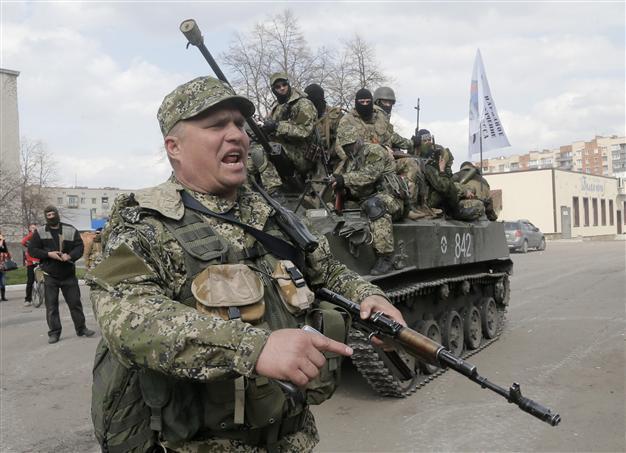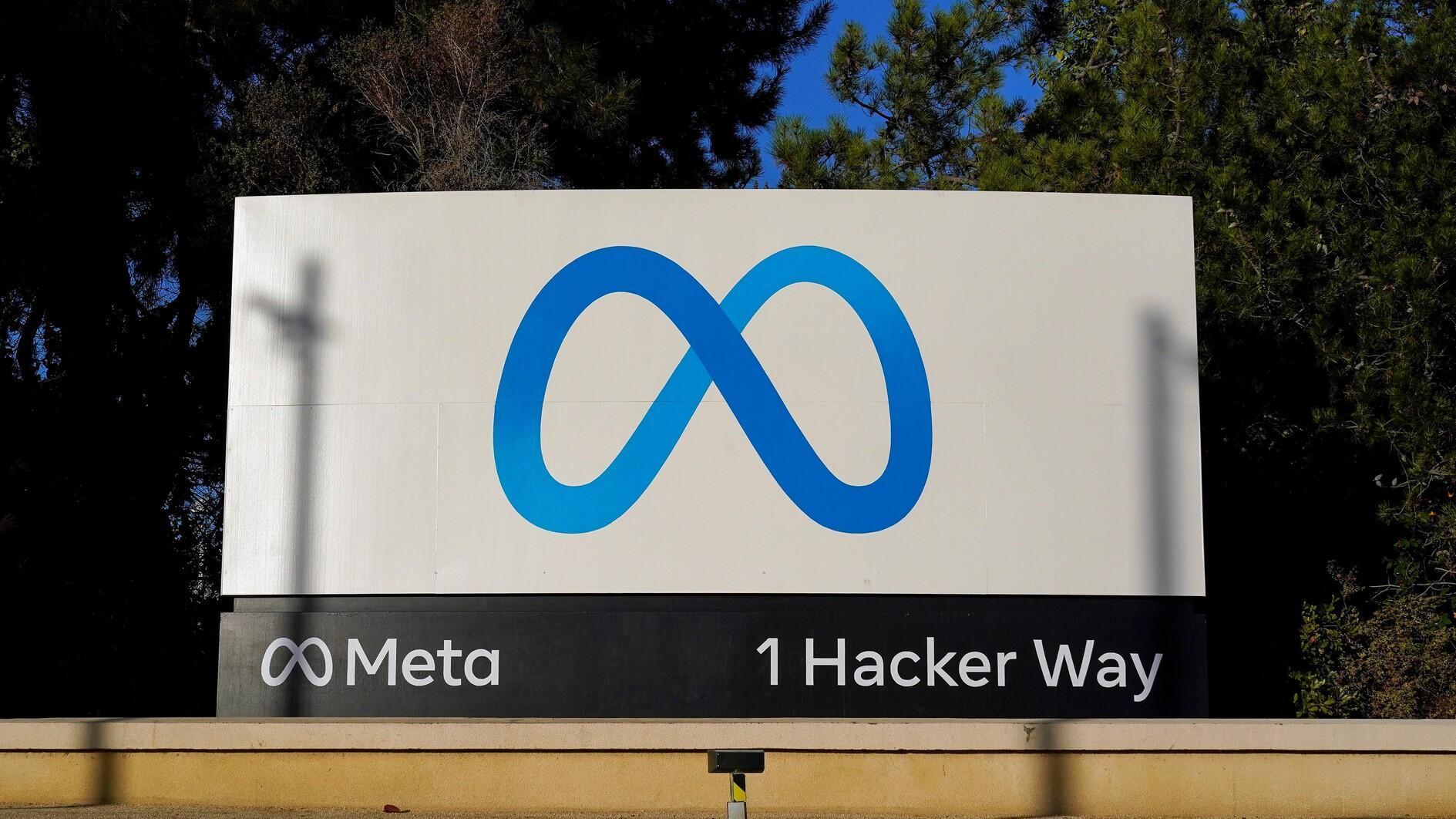Pro-Russia separatists take armoured vehicles of Ukrainian army
KRAMATORSK / SLAVIANSK - Reuters

Pro-Russian gunman clears the way for a combat vehicle with gunmen on top in Slovyansk, Ukraine, Wednesday, April 16. AP Photo
Separatists flew the Russian flag on armoured vehicles taken from the Ukrainian army on April 16, aborting a Kiev government operation to recapture eastern towns controlled by pro-Moscow partisans.Six armoured personnel carriers were driven into the rebel-held town of Slaviansk to waves and shouts of "Russia! Russia!". It was not immediately clear whether they had been captured by rebels or handed over to them by Ukrainian deserters.
Another 15 armoured troop carriers full of paratroops were surrounded and halted by a pro-Russian crowd at a town near an airbase. They were allowed to retreat only after the soldiers had handed over the firing pins from their rifles to a rebel commander.
The Ukrainian government confirmed that six of its armoured vehicles were now in the hands of separatists. Photos of their number markings showed they were among vehicles deployed earlier in the government's attempted "anti-terrorist" operation.
Kiev had sent the convoy of paratroops to capture an airfield, the start of an operation to reclaim towns held by separatists who have declared an independent "People's Republic" in the industrial Donbass region.
The Ukrainian government and its Western allies accuse Russian agents of coordinating the uprising. Moscow denies it is involved and says Kiev is precipitating civil war by sending troops to put down the revolt.
The operation is the first test of Kiev's under-funded army, which had until now played no role in six months of internal unrest. The government seems to have resorted to using troops after losing faith that police in the east would stay loyal.
The military setback leaves Kiev looking weak on the eve of a peace conference on April 16, when its foreign minister will meet his Russian, U.S. and European Union counterparts in Geneva.
Moscow has responded to the overthrow of Moscow-backed Ukrainian president Viktor Yanukovich in February by declaring the interim Kiev government an illegitimate gang of fascists. It has also announced its right to intervene militarily across the former Soviet Union to protect Russian speakers, a new doctrine that has overturned decades of post-Cold War diplomacy.
The EU took a step towards imposing tougher economic sanctions on Russia by informing its member states of the likely impact of proposed measures on each of them. Countries have a week to respond before the European Commission starts drawing up plans for sanctions on energy, finance and trade.
To keep the sensitive material from leaking, each of the 28 member states was told only of the expected risks its own economy would face. The information was handed to each EU ambassador in a sealed brown envelope.
Russia seized and annexed Ukraine's Crimea peninsula last month, and its armed supporters have now taken control over swathes of Ukraine's eastern industrial heartland.
So far, the United States and EU have imposed only targeted sanctions against a list of Russian and Ukrainian individuals and firms, which Moscow has openly mocked. Washington and Brussels say they are working on far tougher measures.
Aborted operation
The government troops began their operation on Tuesday, arriving by helicopter to take control of an airfield at Kramatorsk. They drove armoured personnel carriers flying the Ukrainian flag into the town in the early morning.
But six of those vehicles later rumbled into Slaviansk, 15 km away, with Russian and separatist flags and armed men in motley combat fatigues on top. They stopped outside the separatist-occupied town hall.
Some Ukrainian troops were also taken to Slaviansk with the vehicles, although it was not immediately clear whether they had deserted or were coerced into coming. People in the town said some were sent home in buses.
One soldier guarding one of the vehicles said he was a member of Ukraine's 25th paratrooper division, the unit sent by Kiev to recapture Slaviansk and Kramatorsk.
"All the soldiers and the officers are here. We are all boys who won't shoot our own people," he said, adding that his men had had no food for four days until local residents fed them.
The Defence Ministry in Kiev said the vehicles had been captured. "A column was blocked by a crowd of local people in Kramatorsk with members of a Russian diversionary-terrorist group among them," it said. "As a result, extremists seized the equipment."
Above Slaviansk, a Ukrainian jet fighter carried out several minutes of aerobatics over the town's main square.
Back in Kramatorsk, 15 vehicles from the Ukrainian military convoy sent to recapture the town were stuck near a railroad, blockaded by unarmed local residents. A Ukrainian officer said his men were not prepared to fire on fellow Ukrainians.
"I am a Ukrainian officer, that's the first thing. The other is that I will not shoot at my own people no matter what," said the officer who said he could not give his name as he was not authorised to speak to the media.
"I want things to be normal, people to go back home, not sit in some fields with weapons. I want children to see weapons only on TV ... I want us to live together as we were. And I want to be back home to my wife and child."
The crowd blockaded the troops until the commander of the unit, Colonel Oleksander Schvets, agreed to order his men to hand over the firing pins from their rifles to a separatist leader. The crowd then allowed the troops to drive back to their base in Dnipropetrovsk, a southern city.
The pro-Russian separatists began the uprising in the east by seizing government buildings in three cities on April 6, and have tightened their grip in recent days. Their armed paramilitaries now control buildings in about 10 towns and have seized hundreds of weapons. Two people were killed on Sunday in Slaviansk, including a Ukrainian state security agent shot dead.
Kiev calls the uprising a blatant repeat of the seizure of Crimea, where armed pro-Russian partisans also occupied buildings, declared independence and proclaimed themselves in charge of state bodies. The main difference so far is that Russian troops have not appeared overtly as they did in Crimea, where Moscow already had military bases.
NATO says there are 40,000 Russian soldiers amassed on the frontier, forces which could capture eastern Ukraine in days.
Hopes are faint for any progress at the talks in Geneva on April 16 As in the case of Crimea last month, diplomacy appears to have fallen far behind the pace of events on the ground, with pro-Russian partisans establishing control of territory before Western countries can muster a response.
















